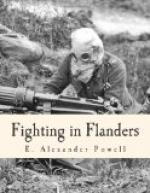The carabineers, for example, wore uniforms of bottle-green and queer sugar-loaf hats of patent leather which resembled the headgear of the Directoire period. Both the grenadiers and the infantry of the line marched and fought and slept in uniforms of heavy blue cloth piped with scarlet and small, round, visorless fatigue-caps which afforded no protection from either sun or rain. Some of the men remedied this by fitting their caps with green reading-shades, such as undergraduates wear when they are cramming for examinations, so that at first glance a regiment looked as though its ranks were filled with either jockeys or students. The gendarmes—who, by the way, were always to be found where the fighting was hottest—were the most unsuitably uniformed of all, for the blue coats and silver aiguillettes and towering bearskins which served to impress the simple country-folk made splendid targets for the German marksmen. This medley of picturesque and brilliant uniforms was wonderfully effective, of course, and whenever I came upon a group of lancers in sky-blue and yellow lounging about the door of a wayside tavern or met a patrol of guides in their green jackets and scarlet breeches trotting along a country-road, I always had the feeling that I was looking at a painting by Meissonier or Detaille.
At the beginning of the war the Belgian cavalry was as well mounted as that of any European army, many of the officers having Irish hunters, while the men were mounted on Hungarian-bred stock. The almost incessant campaigning, combined with lack of proper food and care, had its effect upon the horses, however, and before the campaign in Flanders was half over the cavalry mounts were a raw-boned and sorry-looking lot. The Belgian field artillery was horsed magnificently: the sturdy, hardy animals native to Luxembourg and the Ardennes making admirable material for gun-teams, while the great Belgian draught-horses could scarcely have been improved upon for the army’s heavier work.




